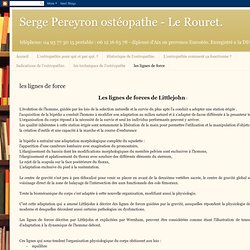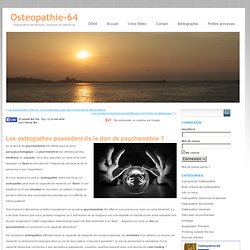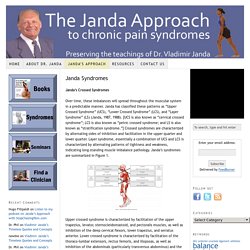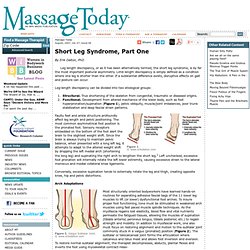

www.apgds.com/sites/apgds/pages/medias/documents/losteopathe-methodegdscouverture1.pdf. Les lignes de force. Les lignes de forces de Littlejohn : L’évolution de l’homme, guidée par les lois de la selection naturelle et la survie du plus apte l’a conduit a adopter une station érigée . l’acquisition de la bipédie a conduit l’homme à modifier son adaptation au milieu naturel et à s’adapter de facon différente à la pesanteur terrestre.

L’organisation du corps répond à la nécessité de la survie et seul les individus performants peuvent y arriver. Les ostéopathes possèdent-ils le don de psychométrie ? Ici, le terme de psychométrie est utilisé dans le sens para-psychologique.

La psychométrie est utilisée par des médiums ou voyants. Vous leur apportez un objet et ils vont ressentir un flash et vont décrire l’histoire de cet objet et de la personne à qui il appartient. Si nous ramenons cela à l’ostéopathie, alors est-ce qu’un ostéopathe peut avoir la capacité de ressentir un “flash” d’une situation ou d’une émotion en touchant un patient (l’objet) et arriver à décrire des circonstances précises qui ont affecté ce même patient? Tout d’abord il faut arriver à définir exactement ce qu’est la psychométrie. En effet si vous prenez en main un verre ébréché, il y a de forte chance que vous puissiez imaginer qu’il soit tombé de sa longueur sur une assiette ou heurté à une autre vaisselle lors de son rangement. Postural Balance, Taos, New Mexico. Postural Distortion occurs when there is an imbalance of the musculoskeletal system resulting from movement of the body off the coronal, midsagittal or horizontal planes.
Due to the body, trying to compensate in an effort to maintain structural balance, muscle contraction and trigger point (TrPs) formation occurs; which results in body dysfunction and pain. This dysfunction and pain stems from the tight and short muscles pulling joints out of alignment and stretching/elongating their antagonist muscles causing them to become weak. Despite their pain, myofascial TrPs are not directly life threatening, but their pain can, and often does, devastate the quality of life. Postural Distortions Layer Syndrome Pattern (Jull & Janda 1987) in which patterns of weakness shortness are viewed from a different perspective.Flat Back & Sway Back Postures (Kendall et al 1993) which have their own individual patterns of weakness & shortness.
Postural Influences Elevation of Shoulder Girdle. edgecliffphysio.com.au/site/wp-content/uploads/JBMTpaper-part1-Jan-08.pdf. edgecliffphysio.com.au/site/wp-content/uploads/JBMTPaper-part2.pdf. www.carolinechaud-osteopathe.fr/wp-content/uploads/2012/09/mémoire-écrit-final-2012.pdf. Trigger points and muscle chains in osteopathy - Philipp Richter, Eric Hebgen. ChiroMatrix 3D Spine Simulator - Nerve Chart. Janda Syndromes. Janda’s Crossed Syndromes Over time, these imbalances will spread throughout the muscular system in a predictable manner.

Janda has classified these patterns as “Upper Crossed Syndrome” (UCS), “Lower Crossed Syndrome” (LCS), and “Layer Syndrome” (LS) (Janda, 1987, 1988). [UCS is also known as “cervical crossed syndrome”; LCS is also known as “pelvic crossed syndrome; and LS is also known as “stratification syndrome.”] Crossed syndromes are characterized by alternating sides of inhibition and facilitation in the upper quarter and lower quarter. Layer syndrome, essentially a combination of UCS and LCS is characterized by alternating patterns of tightness and weakness, indicating long-standing muscle imbalance pathology. Upper crossed syndrome is characterized by facilitation of the upper trapezius, levator, sternocleidomastoid, and pectoralis muscles, as well as inhibition of the deep cervical flexors, lower trapezius, and serratus anterior. Building a Rationale for Evidence-Based Prolotherapy in an Orthopedic Medicine Practice: Part IV: Diagnosing Linked Prolotherapy Targets by Applying a Data-based Biotensegrity Model.
Patients with sacral dysfunction routinely present sequentially-linked targets for Prolotherapy of varying severity from the plantar arch to the nuchal line.

Part I of this series presented the logical development of Prolotherapy, highlighting Empirical, Deductive, Inductive, and Abductive analytical reasoning (IDEA).1 Part II discussed the application of the IDEA-based Scientific Method for evaluating Prolotherapy in an Orthopedic Medical setting.2 Part III presented a data-based case series study of chronic back pain due to sacroiliac joint dysfunction (SIJD) treated by Prolotherapy.3 Although that study was nonrandomized and uncontrolled, it strongly suggested important clinical correlations supporting and elucidating the nature of the injury—as well as the efficacy of the Prolotherapy.
Short Leg Syndrome, Part One. Massage TodayAugust, 2007, Vol. 07, Issue 08 By Erik Dalton, PhD Leg length discrepancy, or as it has been alternatively termed, the short leg syndrome, is by far the most important postural asymmetry.

Limb length discrepancy is simply defined as a condition where one leg is shorter than the other. If a substantial difference exists, disruptive effects on gait and posture can occur. Leg-length discrepancy can be divided into two etiological groups: Structural. Figure 1. © www.erikdalton.com Faulty feet and ankle structure profoundly affect leg length and pelvic positioning. Conversely, excessive supination tends to externally rotate the leg and thigh, creating opposite knee, hip and pelvic distortions. Arch Adaptations Figure 2. Biomechanical Relationship of Feet to Pelvis. Full Size Picture 500227-fx57.gif. Full Size Picture 500227-fx56.gif.
Short Leg Syndrome: Part Two. Massage TodayNovember, 2007, Vol. 07, Issue 11 By Erik Dalton, PhD A highly debated postural issue begging for a logical explanation is the "short right-leg syndrome" (Fig. 1).

Although an inferred awareness of right-sided limb-length shortness has existed for centuries, along with decades of published research, no one has provided a universally acceptable answer to two very important questions: Why the unusual frequency of short right legs seen in clinic? How does this common postural pattern cause compensatory hip, back and pelvic pain? Let's begin by reviewing notable research regarding functional and structural short right legs and then discuss theories, assessments and corrections that help deal with this troublesome disorder. IMG.jpg (1599×1942) YouTube One Channel : osteopathy.